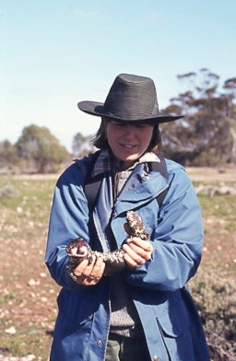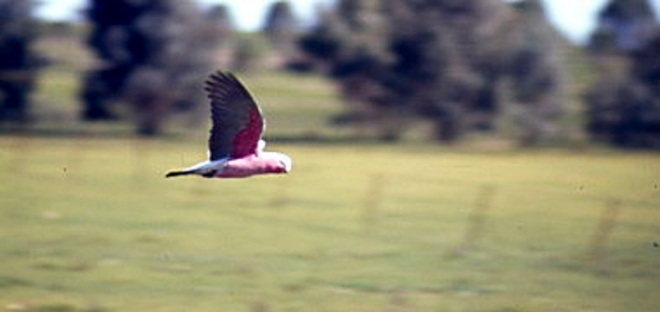
We’ve all seen the horrendous news coming out of Australia about their dreadful wildfires. My thoughts went back to the month I spent in Australia in the early 1980s. For two weeks I volunteered on an Earthwatch expedition in South Australia, helping collect data for a group of American graduate students from Cornell who were studying the native flora and fauna. My team members were wonderful, diverse American women who shared an interest in wildlife and travel. One of my teammates was Sy Montgomery, who since has become an acclaimed nature writer of numerous books. At the time, we were both journalists and nature geeks, and we haven’t changed much since then. Our team was camped at Brookfield Conservation Park, which is affiliated with Chicago’s Brookfield Zoo. Our leader, Dr. Pamela Parker was a conservation biologist with the zoo then, but has been assistant director there for some time and is still very active in Australian wildlife research.
For two weeks after that I toured South Australia, New South Wales and Northern Territory. It was an incredible experience and one that will always be a fond memory.
I wrote this piece for Earthwatch’s magazine back then, but they did not use it.
So it seems timely to post this now.


*Photos included here are from scans of my color slides and B&W negatives.
We slice through the darkness with powerful spotlights. My beam illuminates something in the distance – the yellow glint of eyes. Instantly, I sweep back to the spot. We fix our binoculars on the eyes and discover they belong to a kangaroo. Panning the beam slightly, I see there are two kangaroos, frozen briefly in the light. We spend a minute just watching the creatures grazing and moving awkwardly about. Then, we slowly drive on, searching for more animals.
Our project, “Drought Refugia,” has brought us to Brookfield Conservation Park in South Australia.

We’ve come here to study the flora and fauna, with an emphasis on the Southern hairy-nosed wombat. The park was set up as a wombat preserve, but it’s also a refuge for kangaroos and other animals. Last year’s drought had a huge impact on the ecosystems here, and plant and animals alike suffered. Spotlighting is kind of a bonus activity for us volunteers. The researchers do it to catch animal behavior that they can’t see during the day.
Tuesday
As our principal investigator, Dr. Pamela Parker, gives us a tour of the park, we pause to watch a small group of gray kangaroos, survivors of the drought.

We also feast our eyes on some beautiful birds –swift-flying mallee ring-necked parrots, raucous gray and pink galahs, and a tiny, vivid blue Splendid Fairy Wren.

Further down the park’s dirt track, we get out of the car for a close look at a wombat warren.
Here, we get our first look at results of the drought – remains of a wombat that had starved to death.

- Pam drives on, rattling off names of trees and shrubs we pass on the way – mallee… acacia… triodia… spinifex.
-

Spinifex grows in circles
“How do you spell that? How big does it grow? Does it flower? Is it good food for the animals?” Our questions are endless.



Thursday
Today, I and another volunteer are inspecting color-coded wombat warrens.

We stride across the sparsely vegetated, rock-strewn landscape, going from one warren to the next. We look for signs of activity, either by wombats or other animals, like rabbits or foxes.
We search for the most important unmistakable sign of wombats – fresh fecal pellets. Finding fresh pellets is not difficult, but identifying them can be confusing.

Just when you think you’ve got them pegged as wombat, Pam tells you that female grey kangaroo pellets can resemble wombat.
So, one of the things we learn to do is break open the pellets and examine the plant fibers inside. This takes some getting used to, handling fecal pellets, but after a while our curiosity overtakes our reluctance. Wombat fecal pellets contain short, fine fibers, while kangaroo pellets have fibers of varying lengths and textures. Even Pam sometimes has trouble telling the difference, so I don’t expect to become an expert in two weeks. But my partner and I give it our best try.
Another part of our warren study is to record the number of burrows. A warren can contain anywhere from two to more than 25 burrows in its elaborate tunneling system. After our first few inspections, we learn to walk gingerly over the warrens.

More than once we’ve felt our footing suddenly give way. In many instances, we come across bones and carcasses where starving wombats finally collapsed. It’s clear that the foxes found plenty to scavenge.

Saturday
The research atmosphere in the park is very relaxed. I’m a bit surprised at the research staff’s willingness to trust us with pieces of their important projects. They send us out to collect specific data: avian use of water at troughs; wombat activity; fecal pellet transects, and rabbit behavior. We plunge into our work enthusiastically, trying out our new gear – binoculars, compasses and field guides.
We get to choose what we want to do, and the work gives us some private time alone with our thoughts.

One of the first things we learn is that “negative data is still data.” So, it’s important for us to note the absence of wildlife during our observations, as well as any activity. We have opportunities to see not only wombats, but red and grey kangaroos, lizards, echidnas, and many species of birds, including emus.





Saturday Night
Tonight I am spotlighting again. We go bundled against the mild winter night, standing in the open back of a four-wheel-drive vehicle, armed with spotlights in search of animals. Each of us is eager to see the wildlife that is so evasive during the day, and a little crisp night air isn’t enough to keep us glued to the campfire or in our tents. On our trip we glimpse a wombat before it disappears down a burrow. Then we spot a fox, hungrily tearing at some food, and later, a tawny frogmouth, a bird of prey.
Monday
What a lucky sight! Two emus have come to drink at the trough I’m watching.

Until now, none of the volunteers had seen any signs on them except for their flat, circular “pies.” I suspect the emus are a male and female, after checking the head coloring in the field guide. As they are drinking, the emus are making low, booming sounds. When they finish drinking, they walk off as quietly as they came.
Thursday
The vegetation research is expanding and we have a chance to record density, growth and variety of species. 
Only after getting down on my hands and knees do I discover the beauty of the microscopic flowers: candy cane-striped spears the size of toothpicks, and tiny yellow, purple and white flowers. 

They all seem so fragile, I’m afraid to step anywhere. Pam says some of the plants take years to regenerate. In times of little or no rainfall, their root systems stay alive, enabling the plants to spring to life at the next rainfall. Pam has been very excited at the return of ephemeral plants and flowers, and her excitement infects us all. 
More and more, we realize the devastation of the drought.

Sunday
Brookfield Conservation Park has been a marvelous learning experience.
We’ve seen and done things no ordinary tourist ever could. The clear skies, sunsets and star-filled nights, the moaning ravens, bounding kangaroos, wombats and the warmth and patience of Dr. Parker, the research staff, and the park ranger are hard to leave behind.
I, for one, vow to return.
* * * * * * * * * * * * * * * * * * * * * * * *

What a fabulous experience you had! It must be expecially painful to hear about the wildfires happening now.
LikeLike
Yes. I did get to see some koalas too and at that time, they were already in trouble from some venereal disease. So now I imagine their population is in dire crisis.
LikeLike
That was a good education. I for one would not have thought of wombats starving, even in a drought. A great article and the photos have scanned well.
LikeLike
Wombats are burrowing animals and don’t wander far from their burrows, so when there’s extended drought, and the vegetation dies, there’s nothing to eat! They don’t migrate to find food.
LikeLike
Thank you for the info. I didn’t know until I read your post that wombats are burrowers.
LikeLike